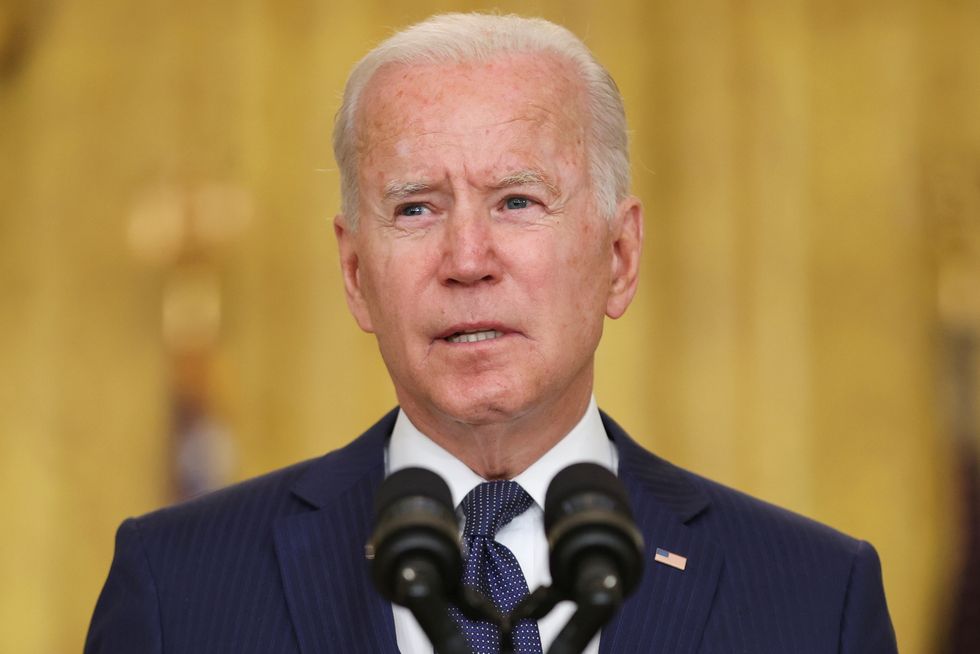Afghanistan latest: US presses on with Kabul evacuations despite fears of more attacks

U.S. President Joe Biden delivers remarks about Afghanistan, from the East Room of the White House in Washington.
JONATHAN ERNST

The US pressed on with its evacuation efforts from Afghanistan amid tighter security measures and fears of more bloodshed, a day after the suicide attack at the Kabul airport that killed scores of Afghans and 13 American service personnel.
The US warned that more attacks could follow ahead of President Joe Biden’s deadline to withdraw American forces from Afghanistan by Tuesday.
Two officials said the Afghan death toll in Thursday’s bombing had risen to 169, while the US said it was the deadliest day for American forces in Afghanistan since August 2011.
Mr Biden blamed the attack on the so-called Islamic State (IS) splinter cell, Isis-K, which is an enemy of both the Taliban and the West.
The Pentagon also said on Friday that there was just one suicide bomber – at the airport gate – not two, as US officials had initially said.
The crowds of people at the airport appeared as large as ever on Friday, despite the bombing.
Afghans, American citizens and other foreigners are all aware that the window is closing to board a flight before the airlift ends and Western troops withdraw.
The names of the Afghan victims have begun to emerge and include the founder of a news agency, along with a number of impoverished Afghans who had gone to the airport in hopes of creating a better life for themselves.
Two British adults and the child of a British national were also among those killed when the bomb exploded in the crowd, officials said.
The 13 US service personnel who died included 10 marines, a navy sailor and an army soldier.
By Friday morning, the Taliban had posted a truck full of fighters and three captured Humvees and set up a makeshift barrier 500 metres (1,600 feet) from the airport, holding the crowds further back from the US troops at the airport gates.
General Frank McKenzie, head of US Central Command, said in the hours after the bombing that America would adjust its security outside the airport gates as needed, including possibly asking the Taliban to change the location of their checkpoints.
Gen McKenzie said American forces had to stand close to would-be evacuees to make sure they were not carrying any weapons that could cause even greater loss of life aboard a plane.
“Somebody has actually got to watch someone else in the eyes and decide that they’re ready to come in” the airport gates, Gen McKenzie said.
In an emotional speech on Thursday, Mr Biden vowed to complete the evacuation and hunt down the IS militants responsible for the attack.
Isis-K is more radical than the Taliban fighters who seized power less than two weeks ago in a lightning blitz across the country.
“We will rescue the Americans, we will get our Afghan allies out, and our mission will go on,” Mr Biden said.
The Taliban have wrested back control of Afghanistan two decades after they were ousted in a US-led invasion following the 9/11 attacks.
Their return to power has terrified many Afghans, who fear they will reimpose the kind of repressive rule they did when they were last in control. Thousands have rushed to flee the country ahead of the American withdrawal as a result.
The US said more than 100,000 people had been safely evacuated from Kabul, but thousands more were struggling to leave in one of history’s largest airlifts.
The White House said on Friday morning that 8,500 evacuees had been flown out aboard US military aircraft in the previous 24 hours, along with around 4,000 people on coalition flights.
The UN refugee agency said a half-a-million people or more could flee from Afghanistan in a worst-case scenario over coming months.
More European allies and other nations were ending their airlifts on Friday, partly to give the US time to wrap up its own operations and get 5,000 of its troops out by Tuesday.
The Taliban have said they will allow Afghans to leave via commercial flights after the US withdrawal, but it remained unclear which airlines would return to an airport controlled by the militants.
Untold numbers of Afghans, especially ones who had worked with the US and other Western countries, are now in hiding, fearing retaliation despite the group’s offer of full amnesty.
The new rulers have sought to project an image of moderation in recent weeks – a sharp contrast to the harsh rule they imposed from 1996 to 2001, when they required women to be accompanied by a male relative when they left home, banned television and music, and held public executions.
Despite the promises, Afghans in Kabul and elsewhere have reported that some Taliban members are barring girls from attending school and going door-to-door in search of people who worked with Western forces.